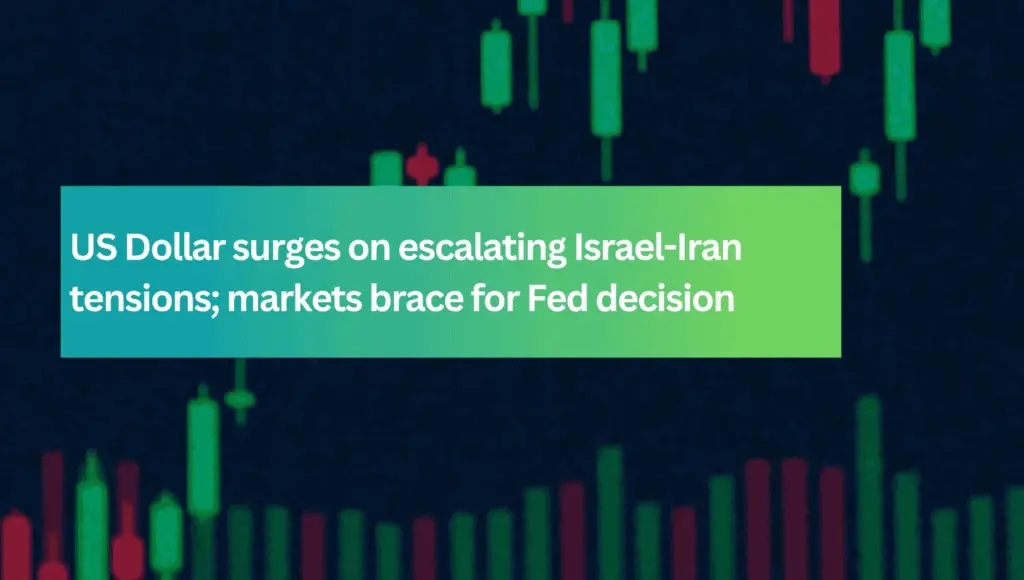News

The U.S. dollar index recorded its strongest daily rally in approximately a month on Tuesday, fueled by escalating geopolitical tensions between Israel and Iran, reigniting global investors’ appetite for safe-haven assets. The sharp increase in conflict intensity in the Middle East prompted broad risk aversion, causing traders to rotate back into the perceived safety of the U.S. dollar. Adding to investor caution, crude oil prices surged sharply, climbing around 3%, overshadowing earlier optimism from an International Energy Agency (IEA) report that suggested ample global oil supply conditions throughout 2025. This spike in oil prices renewed concerns about potential inflationary pressures, complicating the monetary policy outlook and further enhancing the dollar's attractiveness as a protective investment in uncertain times. US economic data disappoints, reinforcing cautious market sentiment Investor mood was further dampened by weaker-than-expected U.S. economic indicators released on Tuesday. Retail sales data for May showed a steeper-than-anticipated decline, signaling underlying softness in consumer spending. Simultaneously, homebuilder sentiment dropped to its lowest level in two-and-a-half years, underscoring increasing vulnerabilities within the U.S. housing sector. The subdued economic data pressured U.S. Treasury yields downward across the maturity spectrum, with yields falling between 4 and 7 basis points. The resulting flattening of the yield curve indicated growing market skepticism regarding the health of the U.S. economy and reinforced consensus expectations that the Federal Reserve is unlikely to deliver an immediate rate cut at the conclusion of its ongoing two-day policy meeting on Wednesday. Middle East conflict escalates dramatically, driving risk-off positioning The escalating conflict between Israel and Iran emerged as the dominant market theme, transcending conventional military actions to include an extensive digital warfare component. Reports indicated that Israel launched a significant cyberattack targeting Iranian digital infrastructure, significantly heightening market anxieties about broader regional instability. U.S. President Donald Trump adopted an increasingly stern posture, explicitly calling for Iran’s “unconditional surrender” and demanding the immediate abandonment of its nuclear ambitions. Trump further demonstrated U.S. commitment by deploying additional fighter aircraft to the region, emphasizing American resolve and escalating global geopolitical tensions. Adding complexity to the situation, UAE Foreign Minister Sheikh Abdullah bin Zayed publicly warned of potential regional spillover effects, intensifying investors' concerns about wider economic and security implications. Amid these developments, Russian President Vladimir Putin and Chinese President Xi Jinping are reportedly preparing for high-level discussions on the evolving Middle East situation, reflecting heightened international diplomatic concerns and further deepening market unease. Euro and sterling pressured by geopolitical uncertainty and dollar strength EUR/USD retreated sharply, breaking decisively below the key psychological threshold of 1.15 to hit its lowest level in nearly a week. Technical indicators pointed toward key support near 1.14, corresponding to recent price congestion and an ascending 21-day moving average. The euro's decline was accentuated by one-month risk reversal data indicating significantly reduced bullish sentiment among traders, suggesting increasing vulnerability for the single currency amid heightened global uncertainty. GBP/USD faced even greater selling pressure, dropping dramatically by approximately 1%, as investor sentiment turned cautious despite supportive developments in U.S.-UK trade relations. Notably, President Trump formalized a reduction in tariffs on British imports, part of ongoing bilateral trade negotiations. Nevertheless, the pound approached critical technical support near June lows around 1.3417 and its lower Bollinger band at approximately 1.3390, reflecting the dominant impact of geopolitical tensions and broad dollar strength. Yen weakens despite safe-haven backdrop; technical factors in focus Contrary to its typical safe-haven behavior, the Japanese yen weakened against the dollar on Tuesday, with USD/JPY advancing firmly into its technical Ichimoku cloud range between 144.89 and 145.59. The pair’s upward movement was primarily driven by the dollar’s broad-based strength, higher oil prices, and shifting expectations surrounding Wednesday’s pivotal Federal Reserve policy announcement. From a technical perspective, USD/JPY’s clear break into this cloud zone signaled potential for further bullish momentum, contingent upon Fed communications. Large-scale option expiries around the psychologically important 145 level further complicated market positioning, influencing traders' cautious approach. Equities decline amid growing investor caution; commodities reflect mixed sentiment U.S. equity markets mirrored the overall cautious tone, with the S&P 500 index declining by 0.78%, weighed down notably by losses in healthcare and consumer discretionary sectors. This weakness reflected growing investor uncertainty about both domestic economic prospects and the evolving geopolitical landscape. Commodity markets presented a mixed picture. Gold prices were broadly stable, balancing heightened geopolitical-driven demand against dollar strength. Meanwhile, copper prices declined by approximately 0.86%, reflecting investor caution regarding the broader outlook for global economic growth amid escalating uncertainties. Market outlook cautious as traders await key Fed decision Overall, Tuesday’s market movements underscored a pronounced shift toward risk aversion, driven primarily by dramatic geopolitical developments in the Middle East and compounded by weaker-than-anticipated U.S. economic data. As markets move toward Wednesday’s crucial Federal Reserve decision, investors will closely scrutinize Fed Chair Lael Brainard’s statements and updated economic projections to gauge potential shifts in monetary policy stance. These developments, combined with ongoing geopolitical tensions, are likely to maintain heightened volatility and cautious positioning across global financial markets in the days ahead.

The U.S. dollar softened slightly on Monday, pulling back from recent highs as market participants reassessed geopolitical risks following reports of potential diplomatic breakthroughs between Iran, the U.S., and Israel. Despite easing modestly, the dollar index remained within its recent range, reflecting cautious positioning ahead of critical central bank meetings scheduled for this week. Investor sentiment improved cautiously after the Wall Street Journal reported that Iranian officials had approached Arab intermediaries—specifically Qatar, Saudi Arabia, and Oman—to help initiate renewed nuclear negotiations with the United States. U.S. President Donald Trump further encouraged optimism by publicly calling on Tehran to seize this diplomatic opportunity “before it's too late.” The diplomatic overtures significantly reduced market concerns over the possibility of a broad regional conflict, especially as Israel’s military actions remained targeted primarily toward limiting Iran’s nuclear capabilities, as emphasized by Israeli Prime Minister Benjamin Netanyahu in his address to military forces. Equity markets benefit from improving risk appetite Reflecting this moderate easing of geopolitical tensions, risk sentiment broadly improved across global markets. The U.S. equity market responded positively, with the S&P 500 rising 0.81%, led predominantly by gains in consumer discretionary and technology sectors. Market sentiment was further buoyed by the notable pullback in energy prices, as WTI crude fell 2.08%, signaling increased confidence among traders that Middle East oil supplies would remain largely unaffected by recent hostilities. In commodity markets, gold prices retreated by approximately 1.3% as investors booked profits after the precious metal reached an eight-week high during last week's geopolitical uncertainty. Copper prices edged modestly higher, up by 0.24%, supported by encouraging signs of improved consumer demand in China, raising expectations for stronger global industrial activity in the coming months. Euro strengthens cautiously ahead of Fed announcement In currency markets, EUR/USD advanced modestly, benefiting from a weaker dollar and technical factors supportive of potential bullish momentum. However, investors remained cautious, refraining from placing significant directional bets ahead of the pivotal U.S. Federal Reserve policy decision on Wednesday. Market participants are eager for clarity regarding future U.S. interest-rate policy, particularly whether Fed officials will reinforce expectations for rate cuts or adopt a more neutral, data-dependent stance amid recent signs of cooling U.S. inflationary pressures. Yen remains range-bound before key Bank of Japan meeting USD/JPY saw modest gains, yet remained tightly constrained within recent narrow ranges. The pair's Bollinger Band width narrowed sharply, marking its tightest range since January, reflecting investor hesitation ahead of Tuesday’s crucial Bank of Japan meeting. Governor Kazuo Ueda and his policy team face a complex task, balancing rising domestic inflationary pressures with lingering economic uncertainties, leaving investors uncertain whether the BoJ will signal adjustments in policy or maintain its cautious status quo. Sterling resilient ahead of Bank of England decision GBP/USD displayed resilience and edged slightly higher but remained capped beneath key technical resistance levels. Investors maintained cautious optimism toward sterling ahead of Thursday’s highly anticipated Bank of England policy meeting. Persistent inflation pressures coupled with slowing U.K. growth have created uncertainty over the BoE’s next policy move, prompting market participants to closely scrutinize the central bank’s forward guidance for clearer insights into its future rate path. Treasury yields rise moderately, risk-sensitive currencies outperform U.S. Treasury yields edged modestly higher across the curve, rising by 1 to 3 basis points, with the yield curve steepening slightly amid improved global risk sentiment. Meanwhile, risk-sensitive currencies showed notable strength. The Australian dollar significantly outperformed, with AUD/USD rising 0.72% and AUD/JPY climbing sharply by 1.11%, reflecting investors’ cautious optimism on reduced geopolitical anxieties and renewed confidence in diplomatic developments. As global markets move toward critical central bank announcements later in the week, traders will closely watch developments in Middle East diplomacy, U.S. monetary policy signals from the Fed, BoJ’s stance on yen appreciation pressures, and the Bank of England’s economic outlook—all key factors likely to shape market sentiment and currency trajectories through the near term.
